Mini-workshop on TOF and MTD in STAR at NCKU (Tainan, Taiwan)
December 13, 2016
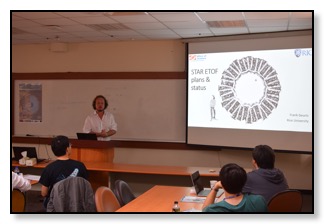
In addition to a review of the existing detectors and the great results that have come out or our starting to come out of these systems, we also discuss future upgrades. At this workshop, Frank presented the plans and current status of the STAR Endcap TOF system (see photo). This detector will feature during the second phase of the Beam Energy Scan (currently scheduled for 2019-2010) and like the BTOF and MTD is based on MRPC technologies.
David Tlusty appointed STAR Physics Working Group convener
November 23, 2016
After consultations from the physics working group (PWG) members and with unanimous agreement from the STAR management team, David Tlusty (Rice) has been appointed by the STAR spokesperson as convener of the recently merged Light-Flavor Spectra/Ultra-Peripheral Collisions PWG. David is the first person who is appointed for this newly merged PWG and will join the current LFS/UPC convener team of Dr. Bingchu Huang (UIC) and Dr. Wlodek Guryn (BNL).
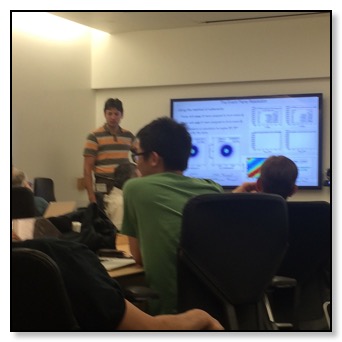
Picture: David presenting his fixed-target analysis at the STAR Analysis Meeting at LBNL (November 2016)

Picture: David presenting his fixed-target analysis at the STAR Analysis Meeting at LBNL (November 2016)
STAR's Event Plane Detector - a first glimpse
November 09, 2016
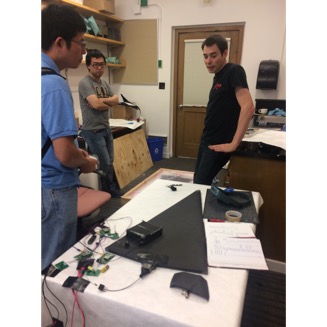
In the picture that I took one can see such an EPD tile and from left to right Zhangbu Xu (STAR spokesperson), Xu Sun, and Alex Schmah (project co-leader). If you look careful, you can see in the back a wooden box in which another EPD tile is already nicely bundled up and ready for shipment.
The tiles will be installed ahead of RHIC Run-17 in order to gain further insights when operating this subdetector in a typical collisions environment.
STAR Analysis Meeting at LBNL
November 06, 2016

Link to the registration page: https://sites.google.com/lbl.gov/star2016
STAR's Endcap TOF: installation of a prototype
October 19, 2016
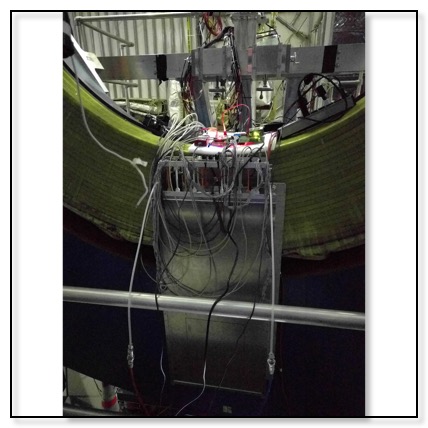
In January next year, shortly before the cooling of the RHIC accelerator, the team will further integrate the eTOF system with STAR's trigger and DAQ systems, as well as connect the clock feed to the common TOF clock that is used for the Barrel TOF and MTD systems.
These eTOF test will provide very relevant data on the its operation inside STAR's environment during actual beam collisions. The final eTOF detector will involve 36 CBM TOF modules and be an essential upgrade for STAR towards the BES phase-2 program (scheduled for 2019-2020). It will extend STAR's particle identification (PID) capabilities to higher momentum in the forward pseudorapidity range provided by the iTPC upgrade. Furthermore, the upgrade will enable a fixed-target program which extends the energy scan to much lower center-of-momentum energies.
Identified Light and Strange Hadron Spectra at √sNN=14.5 GeV [...] (QM2015 proceedings), J.D. Brandenburg
October 05, 2016
Proceedings for The XXV International Conference on Ultrarelativistic Nucleus-Nucleus Collisions: Quark Matter 2015 published in Nucl. Phys. A 956 (2016) 445
Abstract:
With the recently measured Au+Au collisions at √sNN=14.5 GeV, STAR completed its first phase of the Beam Energy Scan (BES) program at RHIC. The main motivation of the BES program is the study of the QCD phase diagram and the search for a conjectured critical point. Amongst the various collision energies of 7.7, 11.5, 19.6, 27, and 39 GeV, that have been previously presented by STAR, collisions at 14.5 GeV will provide data set in the relatively large chemical potential gap between the 11.5 and 19.6 GeV center-of-mass energies. In this contribution, we report new STAR measurements of Au+Au at √sNN=14.5 GeV that include identified light particle RCP and spectra, as well as measurements of the strange hadrons (Ks0, Λ, Ξ, Ω, and φ). The spectra from both light and strange particles cover a significant range of the intermediate transverse momentum (2 < pT < 5 GeV/c) in all beam energies. This provides a unique set of data for a systematic study of the baryon-to-meson ratio at intermediate pT from BES Phase I. We will discuss its physics implications and whether hadronic interactions at late stage dominate the collision dynamics.
Abstract:
With the recently measured Au+Au collisions at √sNN=14.5 GeV, STAR completed its first phase of the Beam Energy Scan (BES) program at RHIC. The main motivation of the BES program is the study of the QCD phase diagram and the search for a conjectured critical point. Amongst the various collision energies of 7.7, 11.5, 19.6, 27, and 39 GeV, that have been previously presented by STAR, collisions at 14.5 GeV will provide data set in the relatively large chemical potential gap between the 11.5 and 19.6 GeV center-of-mass energies. In this contribution, we report new STAR measurements of Au+Au at √sNN=14.5 GeV that include identified light particle RCP and spectra, as well as measurements of the strange hadrons (Ks0, Λ, Ξ, Ω, and φ). The spectra from both light and strange particles cover a significant range of the intermediate transverse momentum (2 < pT < 5 GeV/c) in all beam energies. This provides a unique set of data for a systematic study of the baryon-to-meson ratio at intermediate pT from BES Phase I. We will discuss its physics implications and whether hadronic interactions at late stage dominate the collision dynamics.
Rice Science Café: The Hottest Thing in the Universe
October 04, 2016
Come on over for some #physics, #beers, and a few #quarks …. Churchill room in the Black Lab opens shortly after 6pm, and I start talking shortly after my first beer.
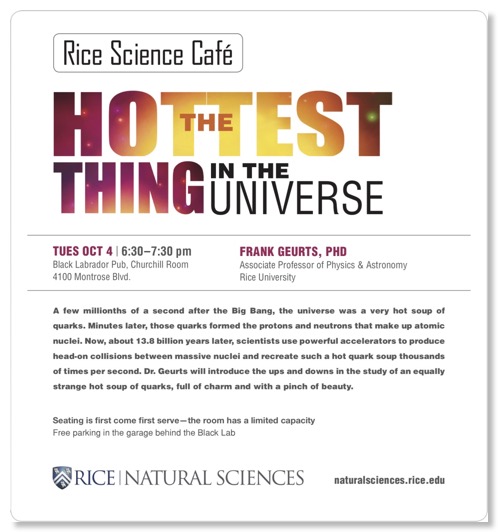

Hard Probes 2020: the Texas Edition
September 27, 2016
Earlier this week, the International Advisory Committee of the 8th International Conference on Hard and Electromagnetic Probes of High-Energy Nuclear Collisions (Hard Probes 2016) announced that the 10th installment of this important conference series will be held in 2020 at UT Austin and involves the collaborative effort of the four main heavy-ion institutes in that region: UT Austin, Texas A&M, Univ. of Houston, and our group at Rice University
The picture below, courtesy of Joey Butterworth, shows the presentation at Wuhan (China) yesterday.
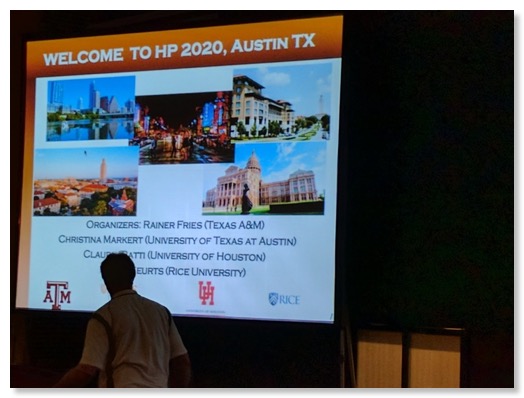
The picture below, courtesy of Joey Butterworth, shows the presentation at Wuhan (China) yesterday.

Identified Light and Strange Hadron Spectra at √sNN = 14.5 GeV with STAR at RHIC BES I (WWND16 proceedings), J.D. Brandenburg
August 24, 2016
Proceedings for 32nd Winter Workshop on Nuclear Dynamics (WWND 2016) published in J.Phys.Conf.Ser. 736 (2016) no.1, 012005
Abstract:
With the recently measured Au+Au collisions at √sNN =14.5 GeV, RHIC completed its first phase of the Beam Energy Scan (BES) program. The main motivation of the BES program is the search for a conjectured critical point and possible first order phase transition. Amongst the various collision energies of 7.7, 11.5, 19.6, 27, and 39 GeV, that have been previously presented by STAR, collisions at 14.5 GeV will provide data set in the relatively large chemical potential gap between the 11.5 and 19.6 GeV center-of-mass energies. In this contribution, we report new STAR measurements of Au+Au at sNN=14.5 GeV that include identified light particle RCP and spectra, as well as measurements of the strange hadrons (Ks0, Λ, Ξ, and Ω). The spectra from both light and strange particles cover a significant range of the intermediate transverse momentum (2 < pT < 5 GeV/c) in all beam energies. We will discuss the physics implications of these observables and whether hadronic or partonic interactions dominate the collision dynamics at a given center-of-mass energy.
Abstract:
With the recently measured Au+Au collisions at √sNN =14.5 GeV, RHIC completed its first phase of the Beam Energy Scan (BES) program. The main motivation of the BES program is the search for a conjectured critical point and possible first order phase transition. Amongst the various collision energies of 7.7, 11.5, 19.6, 27, and 39 GeV, that have been previously presented by STAR, collisions at 14.5 GeV will provide data set in the relatively large chemical potential gap between the 11.5 and 19.6 GeV center-of-mass energies. In this contribution, we report new STAR measurements of Au+Au at sNN=14.5 GeV that include identified light particle RCP and spectra, as well as measurements of the strange hadrons (Ks0, Λ, Ξ, and Ω). The spectra from both light and strange particles cover a significant range of the intermediate transverse momentum (2 < pT < 5 GeV/c) in all beam energies. We will discuss the physics implications of these observables and whether hadronic or partonic interactions dominate the collision dynamics at a given center-of-mass energy.
STAR Collaboration Meeting at OSU
August 15, 2016
This week STAR will have its semi-annual Collaboration Meeting. It will be held at Ohio State University in Columbus, OH. Several members of our group will attend the meeting and present research updates ranging from strangeness measurements in fixed-target collisions, to intermediate-invariant-mass dimuon measurements in p+p collisions.
A link to the Collaboration Meeting's webpage can be found here.
A link to the Collaboration Meeting's webpage can be found here.
#iamaphysicist
May 27, 2016
Happy #iamaphysicist day …
happy #iamaphysicist day ... working to understand the quark gluon plasma with @RHIC_STAR at @BrookhavenLab 🎓👍 pic.twitter.com/PBULRH28Us
— Frank Geurts (@frankgeurts) May 26, 2016
Daniel Brandenburg 2016 Chuoke Award
May 13, 2016
Congratulations to Daniel Brandenburg for receiving the 2016 Chuoke Award in recognition of "graduate students who show the greatest promise in physics as evidenced by performance in course work and speedy progress in research"!
